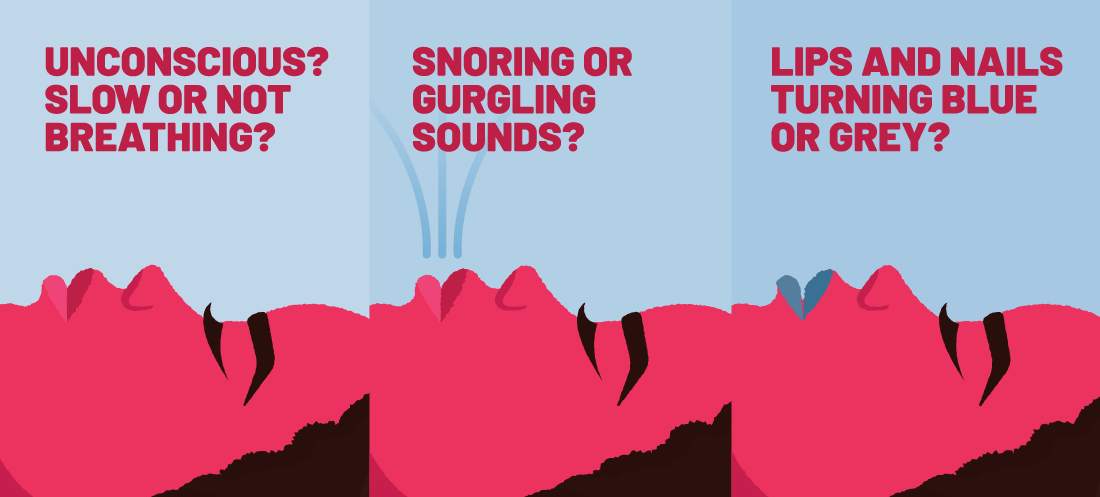![]() If you suspect an overdose, call 9‑1‑1 right away.
If you suspect an overdose, call 9‑1‑1 right away.

Overdose prevention and response
The street drug supply in B.C. is more toxic and unpredictable than ever. Any street drug can be poisoned, not just opioids. It can be hard to know what’s in the substances you’re taking. Even if they came from a source you trust, like a friend or roommate. Even if you only take a little, or if it’s your first time, the risks are real.
It’s important to know how to prevent, recognize and respond to an overdose.
Recognize the signs of an overdose
Do you know how to tell when someone is having an overdose? Look for these signs and symptoms:

Not moving / Unresponsive
The person isn’t moving and can’t be woken up

Slow or no breathing
This means less than 1 breath every 5 seconds

Choking sounds
The person is making unusual sounds, like choking, gurgling, gasping or heavy snoring

Tiny pupils
The person’s pupils look tiny

Blue or grey lips
The person’s fingernails or lips are turning blue, grey or purple

Cold and clammy
The person’s skin feels cold and clammy to the touch

Respond to an overdose
If someone is having an overdose, call 9‑1‑1 right away. Your positive action could save a life. The Good Samaritan Drug Overdose Act protects people who call 9‑1‑1 about overdoses.
After calling 9‑1‑1, follow these SAVE-ME steps:

Stimulate
Try to wake the person. Call their name and squeeze their fingertips or the muscle between their neck and shoulder. If you can’t wake the person, or if you aren’t sure, call 9‑1‑1 right away.

Airway check
Check if they are breathing normally and check for a pulse (heartbeat). Make sure the airway is clear and remove anything in their mouth. Tilt their head back and open their mouth.

Ventilate
Help the person breathe by pinching their nose closed and breathing into their mouth once every five seconds. You can use a breathing mask if you have one.

Evaluate
Are they breathing normally (1 breath every 5 seconds)? If not, get ready to use naloxone.

Medication
Prepare a 1 mL (one millilitre) dose of naloxone. Your kit may include a nasal spray or an injectable liquid—follow the steps to administer it.

Evaluate again
If they are still not breathing normally (1 breath every 5 seconds), give another dose. Keep in mind that naloxone only works for a while. If the drugs are still in the person’s system when the naloxone wears off, they may go back into overdose and need another dose of naloxone.

Aftercare
Put the person on their side and stay with them until emergency services arrive. Naloxone wears off between 30 and 120 minutes and the overdose can return.
Ways to stay safer
Toxic drugs are the leading cause of death for people ages 19 to 39 in B.C. If you or someone you know uses drugs, it’s more important than ever to know the ways to stay safer.

Test your drugs
If you’re planning to use drugs, get them tested, even if you think you can trust your source. Drug checking can provide life-saving information about what’s really in your drugs and can help connect you with health services.
Visit a drug checking site to get your drugs tested.

Carry a naloxone kit
Carry naloxone and know how to use it. Naloxone is a drug that can reverse an opioid overdose from drugs like heroin, methadone, fentanyl, and morphine. Naloxone kits are available for free in B.C. They can be picked up without a prescription at one of 2,320 locations across the province, including community pharmacies.

Download the app
The Lifeguard app connects you to emergency responders if you become unresponsive from a drug overdose.
Download for free through the Apple App Store and Google Play Store.
Get help
If you or someone you know needs support with substance use or addiction, there are ways to get help.
Mental health and substance use supports
It can be challenging finding the help you need online. You may not know where to start. The HelpStartsHere website can help you find supports in your area for mental health and substance use.
Treatment and recovery
Search for supports in your community. This includes intake, substance use/drug use services, counselling, mental health supports, crisis intervention, talklines, or peer-to-peer support.
Supervised sites
Sites where you can use drugs safely, prevent overdoses and access free health services. The staff at these sites are trained to offer support without judging you and will keep your information confidential.
Foundry
At Foundry Centres, young people ages 12-24 can access five core services in one convenient location. These services are: mental health care, substance use services, physical and sexual health care, youth and family peer supports, and social services.
Here2Talk.ca
Connects students with mental health support. If you’re a student at a B.C. college or university (whether you’re from Canada or another country), you can get free, private counseling and community referrals. These services are available 24/7 through an app, phone, or website.
Call 8‑1‑1 for non-emergency help
For medical non-emergencies, call 8‑1‑1 to speak to a health service navigator, who can help you find health information and services.
Sign up for Toxic Drug and Health Alerts
Toxic drug and health alerts are currently available in Interior, Fraser, Northern, Vancouver Island, and Vancouver Coastal Health regions. To sign up, text the word JOIN to 253787 (ALERTS). Message and data rates may apply.